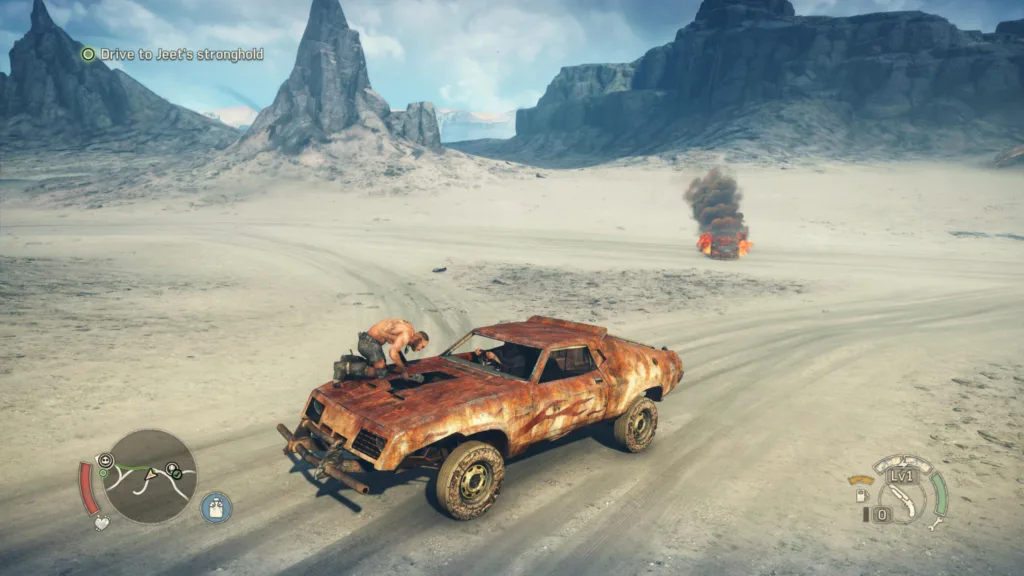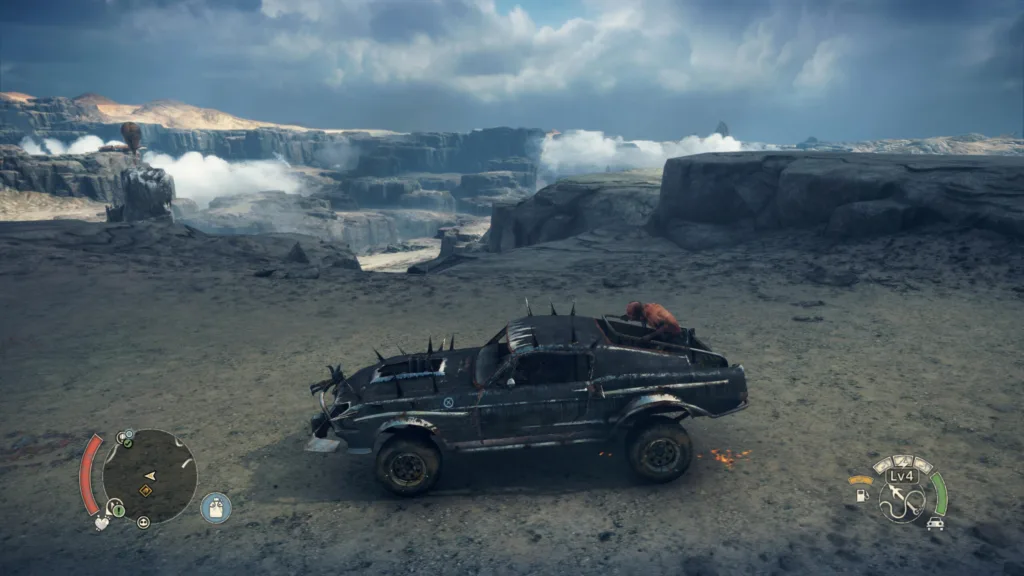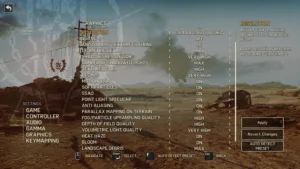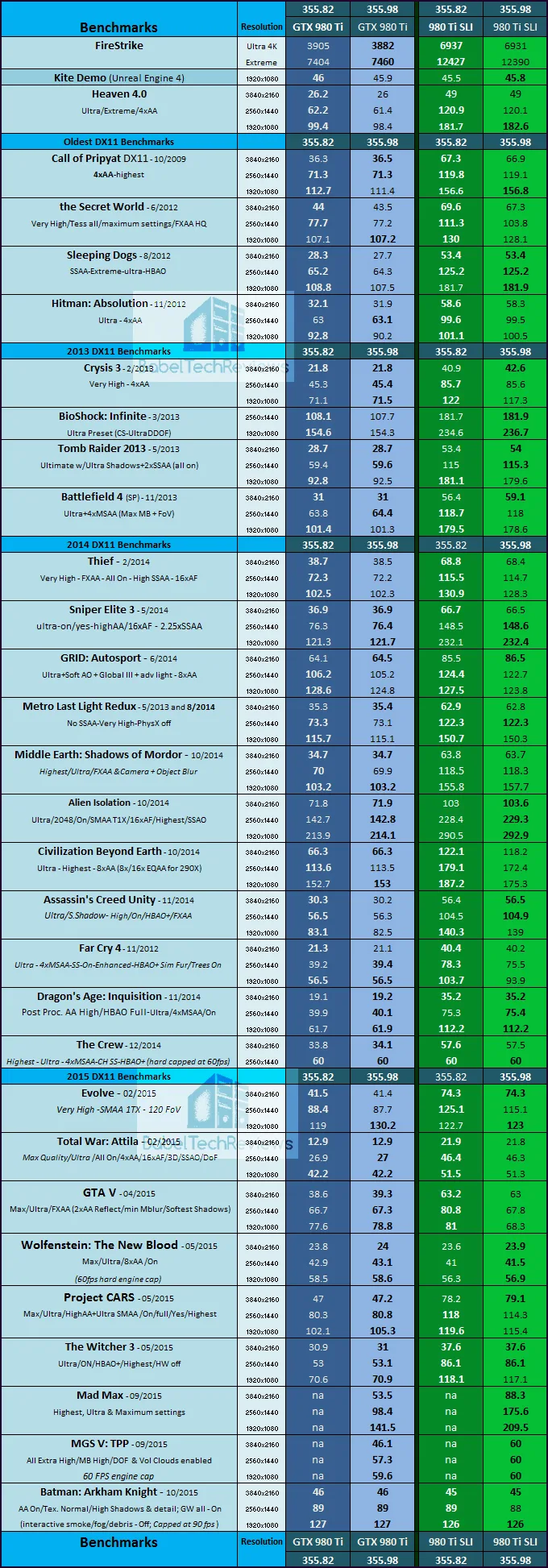 As regularly featured by BabelTechReviews, this performance analysis charts the performance of 28 games using the latest GeForce WHQL 355.98 driver that was released primarily for Killing Floor 2 last week. We are comparing WHQL 355.98 versus the Geforce WHQL 355.82 driver that was released August 31, shortly before Metal Gear Solid V: The Phantom Pain and Mad Max were released. We are going to focus on these two new games as our latest benchmarks that we have played for over 40 hours, so far.
As regularly featured by BabelTechReviews, this performance analysis charts the performance of 28 games using the latest GeForce WHQL 355.98 driver that was released primarily for Killing Floor 2 last week. We are comparing WHQL 355.98 versus the Geforce WHQL 355.82 driver that was released August 31, shortly before Metal Gear Solid V: The Phantom Pain and Mad Max were released. We are going to focus on these two new games as our latest benchmarks that we have played for over 40 hours, so far.
We want to document the performance changes of this current WHQL 355.98 driver on Windows 10. We are also benching for an upcoming evaluation of the new AMD Windows 10 15.9.1 beta driver to be published here this week using the Fury X and 290X versus the GTX 980 Ti and the GTX 970/980 on the latest drivers.
This driver performance analysis features Nvidia’s top Maxwell gaming GeForce card, the GTX 980 Ti, and we also benchmark GTX 980 Ti SLI. Our results should be proportionally similar for the TITAN X, the GTX 980, and the other Maxwell cards. We are going to give you the performance results of the GTX 980 Ti and 980 Ti SLI at 1920×1080, 2560×1440, and at 3840×2160 resolutions. This driver performance evaluation will chart a natural comparison of the performance changes since Nvidia’s late-August WHQL driver set.
We are going to test GeForce WHQL 355.98 driver using our current benchmark suite of 28 games plus 3 synthetic benchmarks. We have added Metal Gear Solid V: The Phantom Pain and Mad Max just for this performance analysis and will also test the GTX 980 and GTX 970 with these two games. Our testing platform is Windows 10 Home 64-bit, using an Intel Core i7-4790K at 4.00GHz which turbos to 4.4GHz for all cores, an ASUS Z97E motherboard, and 16GB of Kingston “Beast” HyperX RAM at 2133MHz. The settings and hardware are identical except for the drivers being tested.
At GTX 760 and above, we test at higher settings and resolutions generally than we test midrange and lower-end cards. All of our games are now tested at three resolutions: 3840×2160, 2560×1440 and 1920×1080 at 60Hz, and we use DX11 whenever possible with a very strong emphasis on the latest games. For our next GeForce performance analysis, we will add the GTX 980 and the GTX 970 results.
Let’s get right to the test configuration, the driver release notes, and then to the results.
Test Configuration & Driver Release Notes
Test Configuration – Hardware
- Intel Core i7-4790K (reference 4.0GHz, HyperThreading and Turbo boost is on to 4.4GHz; DX11 CPU graphics), supplied by Intel.
- ASUS Z97-E motherboard (Intel Z97 chipset, latest BIOS, PCOe 3.0 specification, CrossFire/SLI 8x+8x)
- Kingston 16 GB HyperX Beast DDR3 RAM (2×8 GB, dual-channel at 2133MHz, supplied by Kingston)
- GeForce GTX 980 Ti, 6GB reference clocks, supplied by Nvidia
- EVGA GTX 980 Ti, 6GB, at reference clocks, supplied by EVGA
- GeForce GTX 980, 4GB, reference clocks, supplied by Nvidia
- GALAX GTX 970 EXOC, GALAX factory clocks, supplied by GALAX
- 2TB Toshiba 7200 rpm HDD
- EVGA 1000G 1000W power supply unit
- Cooler Master 2.0 Seidon, supplied by Cooler Master
- Onboard Realtek Audio
- Genius SP-D150 speakers, supplied by Genius
- Thermaltake Overseer RX-I full tower case, supplied by Thermaltake
- ASUS 12X Blu-ray writer
- Monoprice Crystal Pro 4K
Test Configuration – Software
- Nvidia GeForce 355.98 WHQL drivers and GeForce 355.82 WHQL drivers for the GTX 980 Ti including for SLI; also for GTX 980/970. High Quality, prefer maximum performance, single display.
- VSync is off in the control panel.
- AA enabled as noted in games; all in-game settings are specified with 16xAF always applied; 16xAF forced in control panel for Crysis.
- All results show average frame rates except as noted.
- Highest quality sound (stereo) used in all games.
- Windows 10 64-bit Home edition, all DX11 titles were run under DX11 render paths. Latest DirectX
- All games are patched to their latest versions at time of publication.
- PrecisionX, latest version.
The 26 Game benchmarks & 3 synthetic tests
- Synthetic
- Firestrike – Basic & Extreme
- Heaven 4.0
- Kite Demo, Unreal Engine 4
-
DX11
- STALKER, Call of Pripyat
- the Secret World
- Sleeping Dogs
- Hitman: Absolution
- Tomb Raider: 2013
- Crysis 3
- BioShock: Infinite
- Metro: Last Light Redux (2014)
- Battlefield 4
- Thief
- Sniper Elite 3
- GRID: Autosport
- Middle Earth: Shadows of Mordor
- Alien Isolation
- Assassin’s Creed Unity
- Civilization Beyond Earth
- Far Cry 4
- Dragon’s Age: Inquisition
- The Crew
- Evolve
- Total War: Attila
- Wolfenstein: The Old Blood
- Grand Theft Auto V
- ProjectCARS
- the Witcher 3
- Batman: Arkham Origins
- Mad Max
- Metal Gear Solid V: The Phantom Pain, supplied by Nvidia
Let’s first look at Mad Max and MGS V performance using the GTX 980 Ti, 980 Ti SLI, GTX 980, and the GTX 970 EXOC.
Mad Max
Mad Mad has been this editor’s “go-to” game since it released, and we have spent well over 30 hours playing it. It is a lot of fun as the open world is huge, well-designed, and there are a lot of interesting things to do, and the quests are mostly interesting. The world is the same apocalyptic world of the Mad Max movies, but the story is yours as you quest to level up your avatar and your car, the Magnum Opus. You are free to roam and explore as you make allies and perform quests.
On foot combat involves pressing several buttons quickly to attack, parry, or get out of the way. And the player gets a rhythm of attacking that grants a Fury rage mode where extra damage is dealt by the player. At least half of the combat, however, is vehicular. And you will want to upgrade your ride as you progress. Your car and your gear gets better looking and more effective as you go.

Fortunately, the enemies and bosses are reasonably varied and they attack in sufficient numbers so as to present a continual challenge. If there is too much of a challenge, then it is easy to break off the action to continue to loot and perform quests so as to level up your equipment and player. Mad Max is a well-balanced game that beckons the player to return to game for hours on end.

Although Max Max is a console “next gen” port to PC with decent visuals, it is optimized to run well on a midrange system at 1920×1080 or on a high end system at 4K. We have encountered a few irritating bugs, but few crashes. Here are the settings that we used. Every setting is fully maxed out.
 Mad Max ran very smoothly even at 4K with a single GPU video card. We will chart its performance after Metal Gear Solid V.
Mad Max ran very smoothly even at 4K with a single GPU video card. We will chart its performance after Metal Gear Solid V.

Metal Gear Solid V: The Phantom Pain
 The Phantom Pain is an impressive game to end the Metal Gear Solid series with. From before the opening credits, the player is hooked into Kojima’s bizarre world. Don’t try to make sense of this game. It is sometimes ultra violent seemingly for the sake of shock; it is sometimes weird, and the plot doesn’t always mesh, but it is a thrill ride. Unlike the earlier games this one is completely open world and the player can start where he wants.
The Phantom Pain is an impressive game to end the Metal Gear Solid series with. From before the opening credits, the player is hooked into Kojima’s bizarre world. Don’t try to make sense of this game. It is sometimes ultra violent seemingly for the sake of shock; it is sometimes weird, and the plot doesn’t always mesh, but it is a thrill ride. Unlike the earlier games this one is completely open world and the player can start where he wants.
MGS V takes advantage of G-SYNC, Dynamic Super Resolution, and ShadowPlay. Here are the settings that we used to play and benchmark MGS V: TPP with. They are all set to Extra High and On; the very highest settings available to us. This game is quite demanding.
 Here are the performance results benching Mad Max and MGS V: TPP for the GTX 970 EXOC, the GTX 980, the GTX 980 Ti and GTX 980 Ti SLI.
Here are the performance results benching Mad Max and MGS V: TPP for the GTX 970 EXOC, the GTX 980, the GTX 980 Ti and GTX 980 Ti SLI.
As you can see, Metal Gear Solid V is quite demanding on any video card; Mad Max is somewhat less demanding.
Lets look at Nvidia’s release highlights regarding the GeForce 355.98 WHQL driver before we head to performance testing.
Release Notes Highlights for GeForce 355.98
This is a short list highlighting the fact that Nvidia’s WHQL driver release schedule is tied to the release of AAA games. We have played Killing Floor 2 and the gory PhysX visuals are quite impressive. However, it is a very difficult game for us to consistently benchmark.
This new GeForce Game Ready driver ensures you’ll have the best possible gaming experience in Killing Floor 2. This driver is also aligned with the new flagship gaming GPU for notebooks, the GeForce GTX 980. In addition, this Game Ready driver also includes updated features and functionality for the GameWorks VR software development kit (SDK).
Game Ready
Best gaming experience for Killing Floor 2New GeForce GPU
Supports the new GeForce GTX 980 for notebooks, based upon the second-generation Maxwell architectureGameWorks VR Support
Updated driver support for GameWorks VR SDK, adding notebook support, VR SLI enhancements, and bug fixes. Learn more at developer.nvidia.com/vr.
For the comprehensive release notes, you will need to download the .pdf
Let’s head to the chart and compare the driver progress with the GTX 980 Ti and with the GTX 980 Ti SLI since we tested the last time.
Benchmarks & Performance Analysis
Here are our results of 28 games and 3 synthetics compared between GeForce 355.98 WHQL drivers, and GeForce 355.82 WHQL drivers using GTX 980 Ti and GTX 980 Ti SLI. Each set of WHQL drivers are compared against the other in the adjoining results column and the higher performance number is in bold. If there is a tie, both results are given in bold type.
We note mostly small improvements with Nvidia’s new GeForce 355.98 over the older 355.82 drivers, including a few standouts in some games. We generally see improvements and a possible rebalancing of GTX 980 Ti SLI again.
Conclusion:
We would recommend upgrading to the latest GeForce 355.98 driver because there are generally incremental advantages, and no large performance-impacting negatives that we have encountered. It is Nvidia’s latest WHQL driver for Windows 10, and we will be using it next week to compare performance of AMD’s R9 Fury X and 290X with the GTX 980 Ti and with the GTX 980/970.
 GeForce 355.98 is also the driver to use for the latest really fun games that we are playing, including Mad Max, Metal Gear Solid V: The Phantom Pain, and Killing Floor 2. It appears that Nvidia intends to release a WHQL driver with each new major PC game release, and we are looking forward to evaluating the next one. Mad Max and MGS V are a lot of fun and we are using the latest GeForce 355.98 drivers now to play them without major issues.
GeForce 355.98 is also the driver to use for the latest really fun games that we are playing, including Mad Max, Metal Gear Solid V: The Phantom Pain, and Killing Floor 2. It appears that Nvidia intends to release a WHQL driver with each new major PC game release, and we are looking forward to evaluating the next one. Mad Max and MGS V are a lot of fun and we are using the latest GeForce 355.98 drivers now to play them without major issues.
Stay tuned, next up we are benching for an upcoming driver performance evaluation of AMD’s newest Catalyst 15.9.1 Windows 10 driver featuring Fury X, due next week.
Happy gaming!
